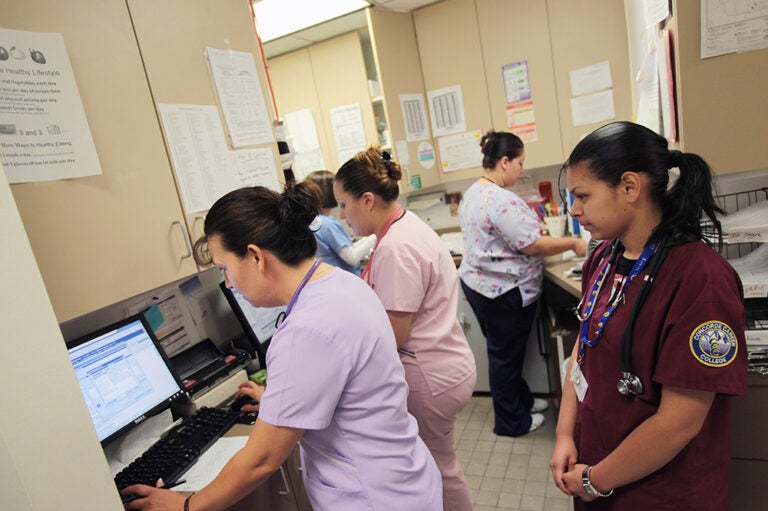The United States spent $4.9 trillion total on healthcare in 2023, according to the Centers for Medicare and Medicaid Services (CMS). In terms of healthcare consumption expenditures, which account for healthcare costs minus investment and research and development costs, the United States spent $4.6 trillion in 2023. But what does that huge number really mean, given the complex, overlapping system of public and private healthcare insurance? Who is “spending” all this money, and who receives it? Here is a breakdown:
- Government insurance programs, such as Medicare and Medicaid, made up 45 percent, or $2.1 trillion, of national healthcare spending.
- Private insurance programs, including employer-provided health insurance as well as plans purchased through the Affordable Care Act, accounted for 32 percent, or about $1.5 trillion.
- Out-of-pocket spending, such as premiums paid by individuals and other out-of-pocket costs, spending by third-party payers, investment in research and equipment, and public health activity accounted for the remaining 23 percent, or $1.1 trillion, of national health spending.
When viewed individually, private insurance programs were the largest single source of funding for healthcare expenditures in 2023, followed by Medicare (22 percent) and Medicaid (20 percent). The amounts paid for particular services vary across insurance programs and have changed over time.
How Do Payments Differ Across Programs?
Payments differ across programs because of various factors, such as the type of services rendered, the population enrolled in each type of program, and certain provisions of law that limit payment for particular goods. For example, Medicare does not allow coverage for hearing aids or dentures. Below is a description of the composition of spending by type of program.
Medicare
Medicare is a federal program that provides health insurance to people who are age 65 or older, blind, or disabled. In 2023, about 65 million Americans received health insurance through the program. The largest component of Medicare spending is on hospital care services, which accounted for 37 percent, or $379 billion, of spending in 2023. Such high levels of spending on hospital care is not surprising, as hospitalizations are associated with high-cost health episodes. However, hospital care has been declining as a share of Medicare spending since a prescription drug benefit became part of the program in 2006. Over the last two decades, spending on prescription drugs grew from less than $2 billion in 2000 to $145 billion in 2023.
Medicaid
Medicaid is a joint federal-state insurance program targeting lower-income Americans. About 92 million Americans, including children below the poverty level, nursing home residents, and non-elderly adults with disabilities, received health insurance through the program in 2023. Medicaid programs are required by law to cover hospital and physician care, but states may also choose to cover other services such as physical therapy and dental care. Medicaid spending for hospital care has been the largest portion of total payments for the program, making up roughly 32 percent of total spending, and is projected to stay relatively stable. Overall, the growth in Medicaid payments is being driven by spending for all other care, which includes dental services, other professional services, and other health, residential, and personal care expenditures. In the past 20 years, such spending has almost quadrupled from $50 billion to $194 billion.
Other Government Programs
Other government insurance programs include the Children’s Health Insurance Program, as well as healthcare provided by the Department of Defense and the Department of Veterans Affairs. Altogether, they accounted for about $193 billion, or 4 percent, of total national health consumption in 2023. Federal, state, and local governments also incurred healthcare costs through public health programs, including relief programs established or enhanced in response to COVID-19.
Private Insurance
Private insurance includes employment-based insurance plans as well as plans directly purchased from the marketplace. In 2023, private insurance programs covered about 207 million people. Among people under age 65, 177 million or 65 percent, were covered by private health insurance in 2023. Spending on hospital care services is the largest source of payment by private insurance programs. Such spending has over tripled in the past two decades, from $181 billion to $559 billion. Another driver of overall growth in spending by private insurance is prescription drugs. Such spending has grown from $84 billion in 2003 to $176 billion in 2023.
How Is Spending Projected to Change in the Future?
CMS projects that federal spending for Medicare and Medicaid and therefore their share of total health spending will increase faster than spending by private insurance. For example, according to their projections from 2024, Medicare spending will climb from about $1.1 trillion in 2025 to $1.9 trillion in 2032, an increase of 69 percent. Medicaid spending would grow from $0.9 trillion to $1.3 trillion, an increase of 53 percent. Meanwhile, spending by private insurance programs would increase from $1.6 trillion to about $2.2 trillion, an increase of 36 percent. By 2032, federal spending would account for 49 percent of the source of funding for healthcare expenditures; private insurance would make up just 30 percent. The rise in government spending on healthcare will be driven partly by the changing demographics, in which the population is growing older and living longer and thereby utilizing more healthcare. In addition, public health spending will also be influenced by additional cost growth, in which healthcare costs outpace the growth rate of the economy.
Conclusion
Healthcare spending is a critically important part of the American economy and the federal budget. Putting the nation on a sustainable fiscal path requires that lawmakers in Washington understand and address the growing budgetary pressure from national healthcare spending. Many solutions exist to improve healthcare performance in the United States by lowering costs and improving outcomes.
Image credit: Photo by Getty Images
Further Reading
Budget Basics: Unemployment Insurance Explained
The Unemployment Insurance program is a key counter-cyclical tool to help stabilize the economy and speed recovery during downturns or crises.
Quiz: How Much Do You Know About Healthcare in the United States?
The United States has one of the largest and most complex healthcare systems in the world. Take our healthcare quiz to see how much you know about the cost and quality of the U.S. healthcare system.
How Did the One Big Beautiful Bill Act Change Healthcare Policy?
The OBBBA adds significantly to the nation’s debt, but its healthcare provisions lessen that impact by $1.0 trillion.


